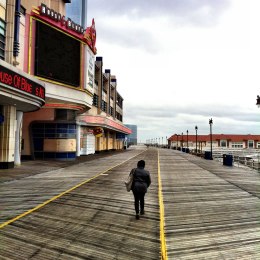
An empty boardwalk in New Jersey near the onset of Hurricane Sandy
Much of the devastation wrought by Superstorm Sandy is highly visible: the homes washed away on the Jersey shore, the extensive flooding in lower Manhattan, the cars floating down the streets in Brooklyn, the dozens of homes burned down in Queens with firefighters unable to control the flames. Estimates for the total cost of the storm currently range from about $20 to $100 billion.
But much of the storm’s damage has yet to be seen. Storms are not only destructive; they’re highly disruptive, and Sandy is likely to be disrupting lives and businesses for some time to come. And it’s in New York and New Jersey where these sorts of disruptions are going to be most fully felt.
While some businesses have been quick to get themselves back up and running – in Brooklyn, some restaurants and bakeries have been operating with a skeleton crew to serve locals and rescue workers, while in Manhattan (the non-flooded parts, anyway) some of the poshest restaurants are once again taking reservations. (Just don’t expect to get an 8:30 res at Dorsia.) But many businesses remain closed, and every day they stay closed means no money coming in – or going out to those who work there.
(MORE: Superstorm Sandy Estimated to Cause $20 Billion in Damage in U.S.)
These closures will hurt small business owners and hourly workers the most. While large businesses insure themselves against the inevitable business disruptions that accompany natural disasters, small businesses are far less likely to. And workers have no insurance to cover lost wages.
In New York and its environs, the cost to workers and small businesses depends in large part on how long it takes electricity to be restored to those currently without it, and how long the subway system remains out of service.
In New York and New Jersey, more than 4 million customers remain without power. Some may have to wait up to ten days for power to be restored. Chuck Watson of risk assessment firm Kinetic Analysis told American Public Media’s Marketplace that power outages account for as much as a third of the total cost from storms.
The transportation problems may be even more dire. With some subway stations in Manhattan literally flooded floor to ceiling with corrosive saltwater, it’s going to take a long time before the system is back up. On Wednesday morning, commuters trying to head to work in Manhattan faced chaos — overcrowded buses, traffic gridlock, and endless delays. Many simply trudged to work on foot.
As Yves Smith notes on the Naked Capitalism blog, many “modestly paid hourly workers,” living paycheck to paycheck,
will be hit hard by the loss of even a week of income. These are the people you might or might not notice, yet are critical to the functioning of the city: the janitors, the cooks and delivery men, the people who run newsstands and dry cleaners and cobblers and food carts, the people who do secretarial and clerical work in businesses large and small throughout the city. And some are in more obviously important support roles, such as hospital orderlies, private duty nurses, home health aides, nurses and dental hygienists.
(MORE: Should the Federal Government Be Subsidizing Flood Insurance?)
For these people, the losses from Superstorm Sandy are only just beginning. “If they’re not working they are not getting paid,” Watson told Marketplace. “They make some of it back in overtime, but for the most part that’s just lost wages for them. You throw in maybe some child care because school’s out, and you’ve got a lot of stress on people just getting by, and on your medium and small businesses.”
Some small businesses — like many retailers — may be able to make up for lost sales when consumers return to their stores and buy what they would have bought earlier. But retail workers can’t make up for their lost wages.
Other businesses aren’t going to be able to make up for lost time. “If people aren’t going to Broadway shows and restaurants and hotels all those businesses that rely on people spending money are going to take a hit for sure,” economist Stephen Bronars told Bloomberg news.
Still, some workers will actually be able to profit from Sandy’s rampage, according to employment consultancy Challenger, Gray & Christmas Inc., with roofers, plumbers, tree-trimmers, and construction workers working overtime to clean up the mess. Utility workers are already working around the clock to restore power.
Even storm clouds have silver linings.
MORE: ‘Hurricane Deductible’: Technicality Could Cost (or Save) Homeowners Thousands

